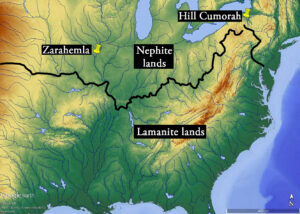
Quoting from Jonathan’s website www.moronisamerica.com:
How can we make sense out of all of this?
The geography becomes more clear when we consult modern revelation.
- Cumorah is in New York (D&C 128)
- Zarahemla is in Iowa (D&C 125)
- The land occupied by the Nephites is north of the Ohio River
- The land occupied by the Lamanites is south of the Ohio River
Everything else fits within this framework.
Errors
1) Error of Omission
Where are Jaredite lands?
This is a common error for all Heartland modelers. They spend an inordinate amount of time on the Land Southward while ignoring the Land Northward entirely.
Why is that important? Because it says that Omer (a Jaredite) passed by where the Nephites were destroyed, which places Jaredite lands south of Lake Ontario.
Where are the four seas that surrounded the Land Northward? Such a configuration is unique and only found in our model—Western New York Model—also called True Book of Mormon Geography Model.
2) Error of Modern Revelation
While the desire to respect the statements of a modern prophet is admirable, how accurate Joseph Smith’s statements were to the geography of the Book of Mormon are not reliable.
This is where Jonathan has painted himself into a corner. In his latest book Infinite Goodness: Joseph Smith, Jonathan Edwards, and the Book of Mormon (Digital Legend Press, 2021) he stipulates that Joseph borrowed from famed preacher Jonathan Edwards and wrote The Book of Mormon.
This, despite the work by Royal Skousen which shows that Joseph Smith was not the author of the sacred text but that it came by revelation, i.e., the gift and power of God as Joseph and the witnesses testified.
So while Jonathan would like to embrace the singular statements by Joseph Smith on Book of Mormon Geography as being by revelation, he is now saying Joseph used his own words (interspersed with Johnathan Edwards’) to write the Book of Mormon, i.e., it was not by revelation.
This is a betrayal as much as it was for the first theorists to suggest there was a 2nd Cumorah in Mesoamerica—they both deny prophecy and genuine revelation. This is how the record was transmitted:
24 …shall READ the words that shall be DELIVERED him (2 Nephi 27)
And this is what Emma told her son, Joseph III, what the process was:
When acting as his scribe, your father would DICTATE to me hour after hour; and when returning after meals, or after interruptions, he would at once begin where he had left off, without either seeing the manuscript or having any portion of it read to him. This was a usual thing for him to do. It would have been improbable that a learned man could do this; and, for one so ignorant and unlearned as he was, it was simply impossible (Vogel, Early Mormon Documents, 1:542).
Young William Smith, brother of Joseph, said this:
That the statements given in the preceding lines concerning the strange visions shown to Joseph Smith, are true; and the translation of the record as found by the brother as stated, is also true, and in no other way did Joseph Smith compile or compose the Book of Mormon only as stated by the gift and power of God. The story that Joseph Smith made up his revelation of the Book of Mormon out of a romance written by one Solomon Spaulding, like many other falsehoods told on the character of the Prophet, by the deceitful and lying stupidity of the age in which we live, must fall to the ground with the rest of their refuge of lies (William Smith on Mormonism, 1883, p. 28).
And this is what Royal Skousen of the Critical Text Project of The Book of Mormon said:
I began to see considerable evidence for the traditional interpretation that witnesses of the translation process claimed: (1) the text was given word for word, (2) Book of Mormon names were frequently spelled out the first time they occurred in the text, and (3) during dictation there was no rewriting of the text except to correct errors in taking down the dictation. Joseph Smith was LITERALLY reading off an ALREADY composed English-language text. The evidence in the manuscripts and in the language of the text itself supports the hypothesis that the Book of Mormon was a precisely determined text. I do not consider this conclusion apologetic, but instead as one demanded by the evidence.
The opposing viewpoint, that Joseph Smith got ideas and he translated them into his own English, cannot be supported by the manuscript and textual evidence. The only substantive argument for this alternative view has been the nonstandard nature of the text, with its implication that God would never speak ungrammatical English, so the nonstandard usage must be the result of Joseph Smith putting the ideas he received into his own language. Yet with the recent finding that the original vocabulary of the text appears to be dated from the 1500s and 1600s (not the 1800s), we now need to consider the possibility that the ungrammaticality of the original text may also date from that earlier period of time, not necessarily from Joseph’s own time and place. JOSEPH SMITH IS NOT THE AUTHOR OF THE BOOK OF MORMON, NOR IS HE ACTUALLY THE TRANSLATOR. Instead, he was the revelator: through him the Lord revealed the English-language text (by means of the interpreters, later called the Urim and Thummim, and the seer stone). Such a view is consistent, I believe, with Joseph’s use elsewhere of the verb translate to mean ‘transmit’ and the noun translation to mean ‘transmission’ (as in the eighth Article of Faith).
With such an untenable mental framework as what Jonathan Edward Neville has chosen to give his ego attention, he has in fact called into question the divine authenticity of The Holy Book of Mormon.